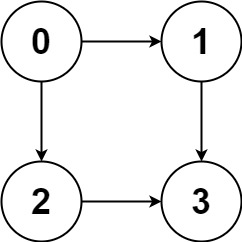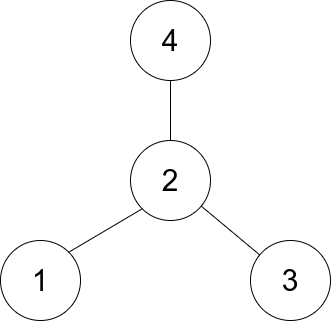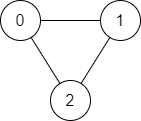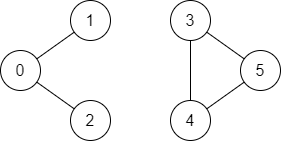Distilled • LeetCode • Graphs
- Pattern: Graphs
Pattern: Graphs
[797/Medium] All Paths From Source to Target
Problem
-
Given a directed acyclic graph (DAG) of n nodes labeled from
0ton - 1, find all possible paths from node0to noden - 1and return them in any order. -
The graph is given as follows:
graph[i]is a list of all nodes you can visit from nodei(i.e., there is a directed edge from nodeito nodegraph[i][j]). -
Example 1:

Input: graph = [[1,2],[3],[3],[]]
Output: [[0,1,3],[0,2,3]]
Explanation: There are two paths: 0 -> 1 -> 3 and 0 -> 2 -> 3.
- Example 2:

Input: graph = [[4,3,1],[3,2,4],[3],[4],[]]
Output: [[0,4],[0,3,4],[0,1,3,4],[0,1,2,3,4],[0,1,4]]
- Constraints:
n == graph.length2 <= n <= 150 <= graph[i][j] < ngraph[i][j] != i (i.e., there will be no self-loops).All the elements of graph[i] are unique.The input graph is guaranteed to be a DAG.
- See problem on LeetCode.
Solution: DFS
- If it asks for just the number of paths, we can generally solve it in two ways:
- Count from start to target in topological order.
- Count using DFS with memo.
- Note that both of them have time \(O(Edges)\) and space \(O(Nodes)\).
- This problem asks for all paths. Memo might not save much time.
- Imagine the worst case that we have \(node-1\) to \(node-N\), and \(node-i\) linked to \(node-j\) if \(i < j\).
- There are \(2^(N-2)\) paths and \((N+2)*2^(N-3)\) nodes in all paths. We can roughly say \(O(2^N)\).
class Solution:
def allPathsSourceTarget(self, graph: List[List[int]]) -> List[List[int]]:
def dfs(cur, path):
if cur == len(graph) - 1:
res.append(path)
else:
for i in graph[cur]:
dfs(i, path + [i])
res = []
dfs(0, [0])
return res
Solution: Recursive One-liner
class Solution:
def allPathsSourceTarget(self, g, cur=0):
if cur == len(g) - 1:
return [[len(g) - 1]]
return [([cur] + path) for i in g[cur] for path in self.allPathsSourceTarget(g, i)]
Complexity
- Time: \(O(n)\)
- Space: \(O(1)\)
[997/Easy] Find the Town Judge
Problem
-
In a town, there are n people labeled from
1 to n. There is a rumor that one of these people is secretly the town judge. -
If the town judge exists, then:
- The town judge trusts nobody.
- Everybody (except for the town judge) trusts the town judge.
- There is exactly one person that satisfies properties 1 and 2.
-
You are given an array trust where
trust[i] = [a_i, b_i]representing that the person labeleda_itrusts the person labeled bi. -
Return the label of the town judge if the town judge exists and can be identified, or return
-1otherwise. -
Example 1:
Input: n = 2, trust = [[1,2]]
Output: 2
- Example 2:
Input: n = 3, trust = [[1,3],[2,3]]
Output: 3
- Example 3:
Input: n = 3, trust = [[1,3],[2,3],[3,1]]
Output: -1
- Constraints:
1 <= n <= 10000 <= trust.length <= 104trust[i].length == 2All the pairs of trust are unique.a_i != b_i1 <= a_i, b_i <= n
- See problem on LeetCode.
Solution: Maintain a score for each person to be a town judge candidate; add/subtract one if the person is trusted/trusts; check for count
from collections import Counter
class Solution:
def findJudge(self, n: int, trust: List[List[int]]) -> int:
# base case: early termination
if n == 1 and trust == []:
return 1
# score for each person to be a town judge candidate
score = Counter()
# if a person trusts another person, decrease their score by one
# (since the town judge trusts nobody)
# if a person is trusted, increase their score by one
# (since everybody trusts the town judge)
for a, b in trust:
score[a] -= 1
score[b] += 1
# count number of people which trust the candidates
# if n-1 people trust one candidate it is the town judge
for i in range(1, n + 1):
if score[i] == n - 1:
return i
return -1
Complexity
- Time: \(O(n)\)
- Space: \(O(1)\)
[1791/Easy] Find Center of Star Graph
Problem
-
There is an undirected star graph consisting of n nodes labeled from
1ton. A star graph is a graph where there is one center node and exactlyn - 1edges that connect the center node with every other node. -
You are given a 2D integer array edges where each
edges[i] = [u_i, v_i]indicates that there is an edge between the nodesu_iandv_i. Return the center of the given star graph. -
Example 1:

Input: edges = [[1,2],[2,3],[4,2]]
Output: 2
Explanation: As shown in the figure above, node 2 is connected to every other node, so 2 is the center.
- Example 2:
Input: edges = [[1,2],[5,1],[1,3],[1,4]]
Output: 1
- Constraints:
3 <= n <= 105edges.length == n - 1edges[i].length == 21 <= ui, vi <= nui != viThe given edges represent a valid star graph.
- See problem on LeetCode.
Solution: Check the first two edges and return the overlapping node
- The solution is based on the following points:
- The center is the only node that has more than one edge.
- The center is also connected to all other nodes.
- Any two edges must have a common node, which is the center.
- We can only check the first two edges and return the common node:
class Solution:
def findCenter(self, edges: List[List[int]]) -> int:
for i in edges[0]:
if i in edges[1]:
return i
class Solution:
def findCenter(self, edges: List[List[int]]) -> int:
return edges[0][0] if edges[0][0] == edges[1][0] or edges[0][0] == edges[1][1] else edges[0][1]
Complexity
- Time: \(O(1)\)
- Space: \(O(1)\)
Solution: Generalized version: find multiple centers in a multi-star graph
class Solution(object):
def findCenter(self, edges):
"""
:type edges: List[List[int]]
:rtype: int
"""
n = max(max(my_list) for my_list in edges)
adj_list = [[] for _ in range(n)]
for edge in edges:
adj_list[edge[0]-1].append(edge[1]-1)
adj_list[edge[1]-1].append(edge[0]-1)
for i in range(len(adj_list)):
if len(adj_list[i]) == n-1:
return i +1
Complexity
- Time: \(O(n)\)
- Space: \(O(1)\)
[1971/Easy] Find if Path Exists in Graph
Problem
-
There is a bi-directional graph with n vertices, where each vertex is labeled from
0ton - 1(inclusive). The edges in the graph are represented as a 2D integer array edges, where eachedges[i] = [u_i, v_i]denotes a bi-directional edge between vertexu_iand vertexv_i. Every vertex pair is connected by at most one edge, and no vertex has an edge to itself. -
You want to determine if there is a valid path that exists from vertex
sourceto vertexdestination. -
Given
edgesand the integersn,source, anddestination, return true if there is a valid path fromsourcetodestination, orfalseotherwise. -
Example 1:

Input: n = 3, edges = [[0,1],[1,2],[2,0]], source = 0, destination = 2
Output: true
Explanation: There are two paths from vertex 0 to vertex 2:
- 0 → 1 → 2
- 0 → 2
- Example 2:


Input: n = 6, edges = [[0,1],[0,2],[3,5],[5,4],[4,3]], source = 0, destination = 5
Output: false
Explanation: There is no path from vertex 0 to vertex 5.
- Constraints:
1 <= n <= 2 * 1050 <= edges.length <= 2 * 105edges[i].length == 20 <= ui, vi <= n - 1ui != vi0 <= source, destination <= n - 1There are no duplicate edges.There are no self edges.
- See problem on LeetCode.
Solution: DFS
class Solution:
def validPath(self, n: int, edges: List[List[int]], source: int, destination: int) -> bool:
graph = self.makeGraph(edges)
return self.depthFirstSearch(graph, source, destination, set())
# format: {x: [y], y: [x]}
def makeGraph(self,edges):
graph = {}
for edge in edges:
x,y = edge
if x not in graph:
graph[x] = []
if y not in graph:
graph[y] = []
graph[x].append(y)
graph[y].append(x)
return graph
def depthFirstSearch(self, graph, node, target, visited):
# base case: reached target
if node == target:
return True
# mark visited nodes
visited.add(node)
for node in graph[node]:
# don't want to visit a visited node
if node not in visited:
if self.depthFirstSearch(graph, node, target, visited):
return True
return False
Complexity
- Time: \(O(n)\)
- Space: \(O(2n + n + n) = O(n)\)